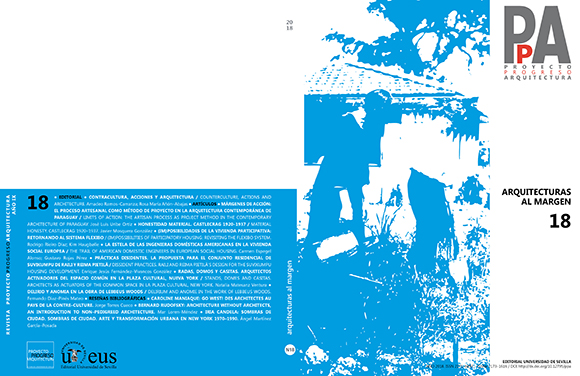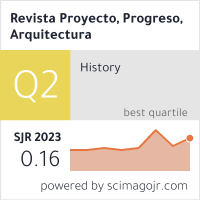DELIRIO Y ANOMIA EN LA OBRA DE LEBBEUS WOODS / DELIRIUM AND ANOMIE IN THE WORK OF LEBBEUS WOODS
DOI:
https://doi.org/10.12795/ppa.2018.i18.07Palavras-chave:
ebbeus Woods, delirio, anomia arquitectónica, marginalidad, anarquitectura, Pabellón de Luz en Chengdu / Lebbeus Woods, delirium, architectural anomie, marginality, Anarchitecture, Light Pavilion in ChengduResumo
RESUMEN El artículo ofrece una perspectiva crítica de la obra de Lebbeus Woods (1940, Lansing, Michigan – 2012, New York), desde el argumento del concepto de delirio. Este enfoque, en paralelo al de la desregulación posmoderna de la disciplina, muestra a la propia arquitectura contemporánea como sujeto delirante y una conducta divergente en Woods derivada de una anomia mayor que la tan extendida en la práctica arquitectónica contemporánea. Para entender la marginalidad de este arquitecto heterodoxo, se esbozan su contexto de procedencia y los datos biográficos básicos, periodizando la trayectoria de su creatividad expansiva en la que el concepto de anarquitectura fue central. Se comprueba así como supera los límites, cercano al delirio en la extensión y gran intensidad de su obra, persistiendo en una experimentación fabuladora y en su renuncia a edificar, en la que resiste durante toda su vida, operando fuera del sistema de códigos y políticas de construcción mucho más allá de cuando esto se consideraba distinguido. Aún cuando su pensamiento es neoliberal, Woods milita en los márgenes del capitalismo hasta que construye su única estructura, invitado por Steven Holl en 2007 a proyectar el Pabellón de Luz en el Sliced Porosity Block, un enorme complejo multifuncional en Chengdu (China). El Pabellón, acabado una semana antes de su muerte, condensa la evolución del ideario de Woods. El análisis de este proyecto sirve de conclusión final.
SUMMARY The article offers a critical perspective of the work of Lebbeus Woods (1940, Lansing, Michigan - 2012, New York), from the argument of the concept of delirium. This approach, in parallel to that of the postmodern deregulation of the discipline, shows contemporary architecture itself as a delirious subject and a divergent conduct in Woods, derived from an anomie greater than that which is so extensive in contemporary architectural practice. In order to understand the marginality of this heterodox architect, his context of origin and basic biographical data are outlined, periodising the career of his expansive creativity, in which the concept of Anarchitecture was central. It is shown how he went beyond the limits, close to delirium, in the extent and great intensity of his work, persisting in fantasist experimentation and in his refusal to build. This he maintained throughout his life, operating outside the system of building codes and policies, well beyond a time when this was considered distinguished. Even though his thinking was neoliberal, Woods served in the margins of Capitalism until he built his only structure. He was invited by Steven Holl, in 2007, to design the Light Pavilion in the Sliced Porosity Block, an enormous multifunctional complex in Chengdu (China). The Pavilion, finished one week before his death, condenses the evolution of Woods’ ideology. The analysis of this project serves as a final conclusion.
Downloads
Referências
ARONOVITZ, Stanley; MARTINSONS, Barbara; MENSER, Michael, eds. Technoscience and Cyberculture. New York: Routledge, 1996.
BEKKERING, Henco. The Architecture Annual 2003–2004: Delft University of Technology, Delft: 010 Publishers, 2007.
BOSSI, Laura, ed. Luce in città / Light in the city. En: Domus. Rozzano: Editoriale Domus Spa, enero 2013, número 965, pp. 29–36. ISSN 0012–537.
BUCHANAN, Peter. Tribune towers. En: The Architects’ Journal. London: Emap Limited, julio, 1980, volumen 172, número 31, pp. 192–193. ISSN 0003–8466.
CASTILLA DEL PINO, Carlos. El delirio, un error necesario. Oviedo: Ediciones Nobel, 1998.
CONRAD, Joseph. The shadow–line. [1917] London: Penguin Books, 1986.
COWAN, Robert. Two halves make a whole new city. En: The Architects’ Journal. London:Emap Limited, noviembre 22, 1989, volumen 190, número 21, p. 15. ISSN 0003–8466.
EVANS, Robin. Traducciones. Gerona: Col–legid’ Arquitectes de Catalunya. Demarcació de Girona / Editorial Pre–textos, 2005.
JACOBSON, Clare, ed. Slow Manifesto. Lebbeus Woods Blog. New York: Princeton Architectural Press, 2015.
JAMESON, Fredric. Las ideologías de la teoría. Buenos Aires: Eterna Cadencia, 2014.
JAMESON, Fredric. The Political Unconscious: Narrative as a Socially Symbolic Act. [1981] London: Routledge, 2002.
KUMPUSCH, Christopha. ed. Urban Hopes. Made in China by Steven Holl. Zürich: Lars Müllers Publishers, 2014.
LAHIJI, Nadir, ed. The political unconscious of architectural. 3ª ed. [2011] New York: Routledge, 2012.
LEACH, Neil. La an–estética de la arquitectura. Barcelona: Editorial Gustavo Gili, 2001.
McCARTER, Robert. Steven Holl. New York: Phaidon, 2015.
MOORE, Rowan, Ill–digested clichés. En: The Architectural Review. London: EMAP Limited, agosto, 1990, volumen 188, número 122, p. 14. ISSN 0003861X.
MORRIS, Mark. Two hundred and eighty–eightlines. En: Log. New York: Anyone Corporation, Winter/Spring 2013, número. 27, pp. 128–136. ISSN 15474690.
MYERS, Tracy; WOODS Lebbeus; HARRIES, Karsten. Lebbeus Woods: experimental architecture. Pittsburg: Carnegie Museum of Art, 2004.
NOEVER, Peter, ed. The End of Architecture? Documents and Manifestos. Munich: Prestel–Verlag, 1993.
PAPADAKIS, Andreas. Theory + Experimentation. An intellectual extravaganza. London: Academy Editions, 1993, p. 53.
WOODS, Lebbeus. After forms. En: Perspecta. Cambridge (USA): The MIT Press, 2006, volumen 38, p. 125–132. ISSN 00790958.
WOODS, Lebbeus. Anarchitecture: Architecture is a Political Act. En: Architectural Monographs. London: Academy Editions, 1992, número 22.
WOODS, Lebbeus. Architecture, consciousness and the mythos of time. En: AA Files. London: Architectural Association School of Architecture, septiembre 1984, número 7, pp. 3–13. ISSN 02616823.
WOODS, Lebbeus. Einstein tomb. Pamphlet Architecture. New York: Princeton Architectural Press, 1980, número 6.
WOODS, Lebbeus. OneFiveFour. New York: Princeton Architectural Press, 1989.
WOODS, Lebbeus. Radical Reconstruction. New York: Princeton Architectural Press, 1997.
WOODS, Lebbeus. System Wien. Ostfildern–Ruit (Alemania): Hatje–Cantz, 2005.
WOODS, Lebbeus. Terra Nova 1988–1991. En: Architecture and Urbanism. Tokyo: a+u Publishing, agosto 1991, número 91.
WOODS, Lebbeus. The Storm and The Fall. New York: Princeton Architectural Press, 2004.
WOODS, Lebbeus. War and Architecture / Rat iArhitektura. Pamphlet Architecture. New York: Princeton Architectural Press, 1993, número 15.
WOODS, Lebbeus; BROWN, Olive; COOK, Peter. Origins. London: Architectural Association, 1985.
Página web de Lebbeus Woods [en línea] [consulta: 16–08–2017]. Disponible en: http://lebbeuswoods.net
Blog Lebbeus Woods [en línea] [consulta: 16–08–2017]. Disponible en: https://lebbeuswoods.wordpress.com
Publicado
Como Citar
Edição
Seção
Licença
Las ediciones impresa y electrónica de esta Revista son editadas por el Secretariado de Publicaciones de la Universidad de Sevilla, siendo necesario citar la procedencia en cualquier reproducción parcial o total.
Salvo indicación contraria, todos los contenidos de la edición electrónica se distribuyen bajo una licencia de uso y distribución “Creative Commons Atribución-NoComercial-SinDerivar 4.0 Internacional” ![]() . Puede consultar desde aquí la versión informativa y el texto legal de la licencia. Esta circunstancia ha de hacerse constar expresamente de esta forma cuando sea necesario.
. Puede consultar desde aquí la versión informativa y el texto legal de la licencia. Esta circunstancia ha de hacerse constar expresamente de esta forma cuando sea necesario.
Los autores/as que publiquen en esta revista aceptan las siguientes condiciones:
- Los autores/as conservan los derechos de autor y ceden a la revista el derecho de la primera publicación, con el trabajo registrado con la licencia de atribución de Creative Commons, que permite a terceros utilizar lo publicado siempre que mencionen la autoría del trabajo y a la primera publicación en esta revista.
- Los autores/as pueden realizar otros acuerdos contractuales independientes y adicionales para la distribución no exclusiva de la versión del artículo publicado en esta revista (p. ej., incluirlo en un repositorio institucional o publicarlo en un libro) siempre que indiquen claramente que el trabajo se publicó por primera vez en esta revista.
- Se permite y recomienda a los autores/as a publicar su trabajo en Internet (por ejemplo en páginas institucionales o personales) antes y durante el proceso de revisión y publicación, ya que puede conducir a intercambios productivos y a una mayor y más rápida difusión del trabajo publicado (vea The Effect of Open Access).









